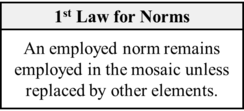Difference between revisions of "The First Law for Norms (Barseghyan-Pandey-2023)"
| Line 19: | Line 19: | ||
|Page Status=Stub | |Page Status=Stub | ||
|Editor Notes= | |Editor Notes= | ||
| + | }} | ||
| + | {{Acceptance Record | ||
| + | |Community=Community:Scientonomy | ||
| + | |Accepted From Era=CE | ||
| + | |Accepted From Year=2024 | ||
| + | |Accepted From Month=February | ||
| + | |Accepted From Day=22 | ||
| + | |Accepted From Approximate=No | ||
| + | |Acceptance Indicators=The law became accepted as a result of the acceptance of modification [[Modification:Sciento-2023-0002|Sciento-2023-0002]]. It replaced [[The First Law for Methods (Barseghyan-2015)]]. | ||
| + | |Still Accepted=Yes | ||
| + | |Accepted Until Era= | ||
| + | |Accepted Until Year= | ||
| + | |Accepted Until Month= | ||
| + | |Accepted Until Day= | ||
| + | |Accepted Until Approximate=No | ||
| + | |Rejection Indicators= | ||
}} | }} | ||
Revision as of 11:34, 20 June 2024
This is an answer to the question Mechanism of Scientific Inertia for Normative Theories that states "An employed norm remains employed in the mosaic unless replaced by other elements."
The First Law for Norms was formulated by Hakob Barseghyan and Aayu Pandey in 2023.1 It is also known as The Law of Scientific Inertia for Normative Theories. It is currently accepted by Scientonomy community as the best available answer to the question.
Contents
Scientonomic History
Acceptance Record
| Community | Accepted From | Acceptance Indicators | Still Accepted | Accepted Until | Rejection Indicators |
|---|---|---|---|---|---|
| Scientonomy | 22 February 2024 | The law became accepted as a result of the acceptance of modification Sciento-2023-0002. It replaced The First Law for Methods (Barseghyan-2015). | Yes |
Suggestions To Accept
Here are all the modifications where the acceptance of this theory has been suggested:
| Modification | Community | Date Suggested | Summary | Date Assessed | Verdict | Verdict Rationale |
|---|---|---|---|---|---|---|
| Sciento-2023-0002 | Scientonomy | 28 December 2023 | Accept new formulations of the first law for theories, norms, and questions that are in tune with the formulation of the first law. Also accept new formulations of the respective rejection theorems - theory rejection, norm rejection, and question rejection. | 22 January 2024 | Accepted | During the 2024 workshop, the bulk of the discussion centered around the inclusion of the first law for norms and norm rejection theorem in the set of formulations to be accepted. Paul Patton contended that norm employment in general had not been demonstrated to be lawful beyond method employment, and our basic formulations should instead concern norm acceptance, which is patently lawful. He argued that the formulations should be modified to pertain either to methods only or to norm acceptance. It was decided that if the community were to remain uncomfortable with accepting Pandey’s new formulations, a revote would likely also need to be taken on Rawleigh’s Sciento-2022-0002, given that the issue of norm employment was also highlighted in discussions of that modification. After extensive discussion, Barseghyan suggested that the first law for norms would only apply to situations where behavior was norm-guided to begin with, which would skirt the difficulty that faces even behavioural psychologists of determining whether human behaviour in general is lawful. The majority of the community was comfortable with this workaround, and the modification was ultimately accepted with over 2/3rds majority assenting, with 11/14 votes to accept (although 1 voter voted to reject the modification and 2 voted to keep it open). |
Question Answered
The First Law for Norms (Barseghyan-Pandey-2023) is an attempt to answer the following question: What makes the normative theories of an agent's mosaic continue to remain in the mosaic?
See Mechanism of Scientific Inertia for Normative Theories for more details.
Description
TODO
Reasons
No reasons are indicated for this theory.
If a reason supporting this theory is missing, please add it here.
Questions About This Theory
The following higher-order questions concerning this theory have been suggested:
If a question about this theory is missing, please add it here.
References
- ^ Pandey, Aayu. (2023) Dilemma of the First Law. Scientonomy 5, 25-46. Retrieved from https://scientojournal.com/index.php/scientonomy/article/view/42258.
